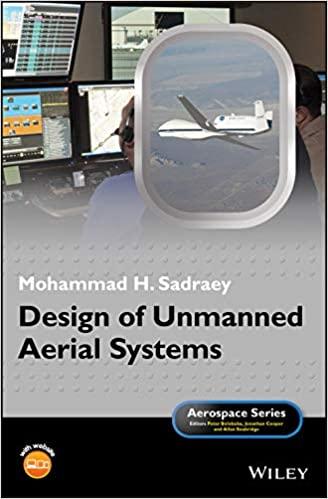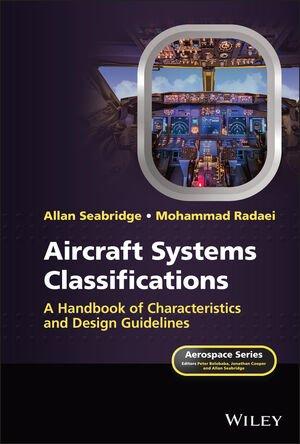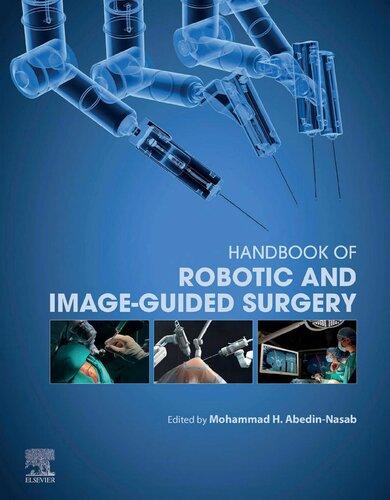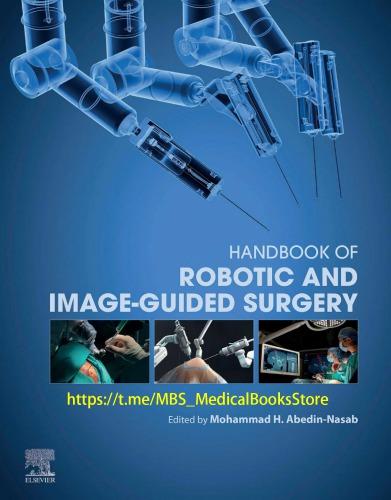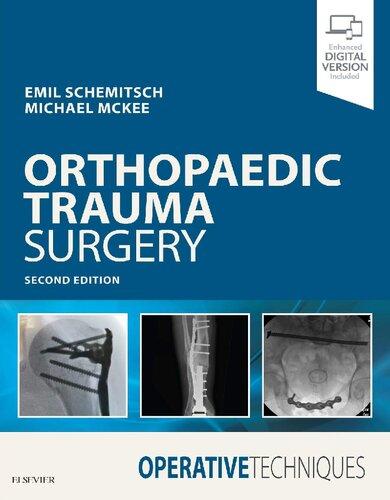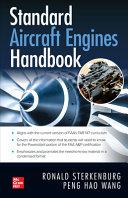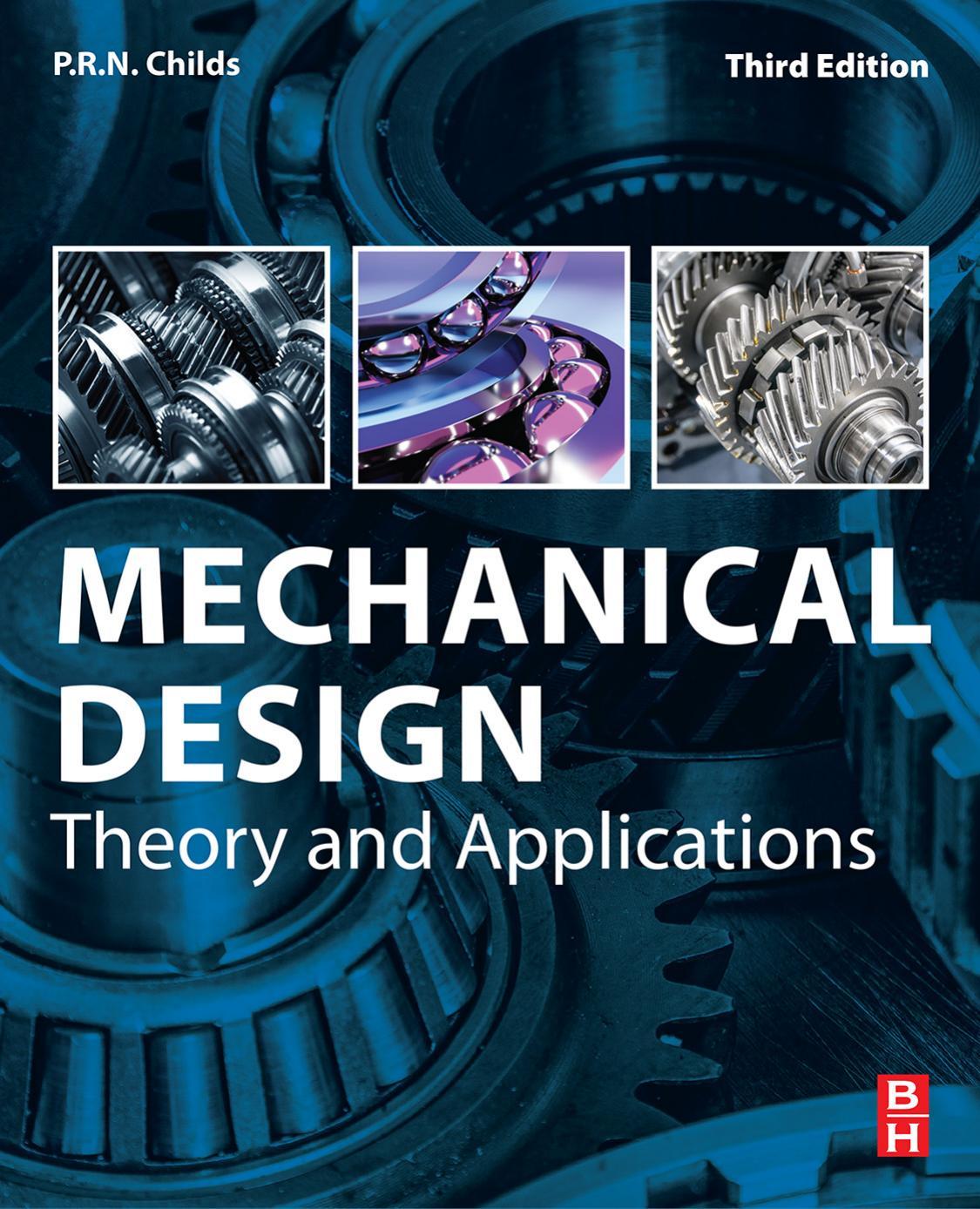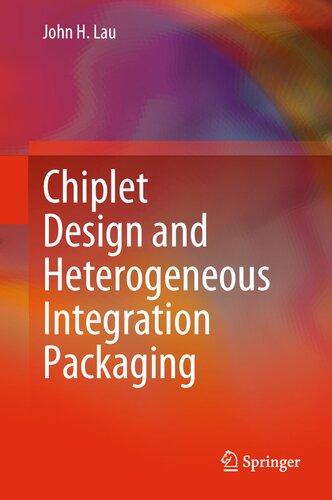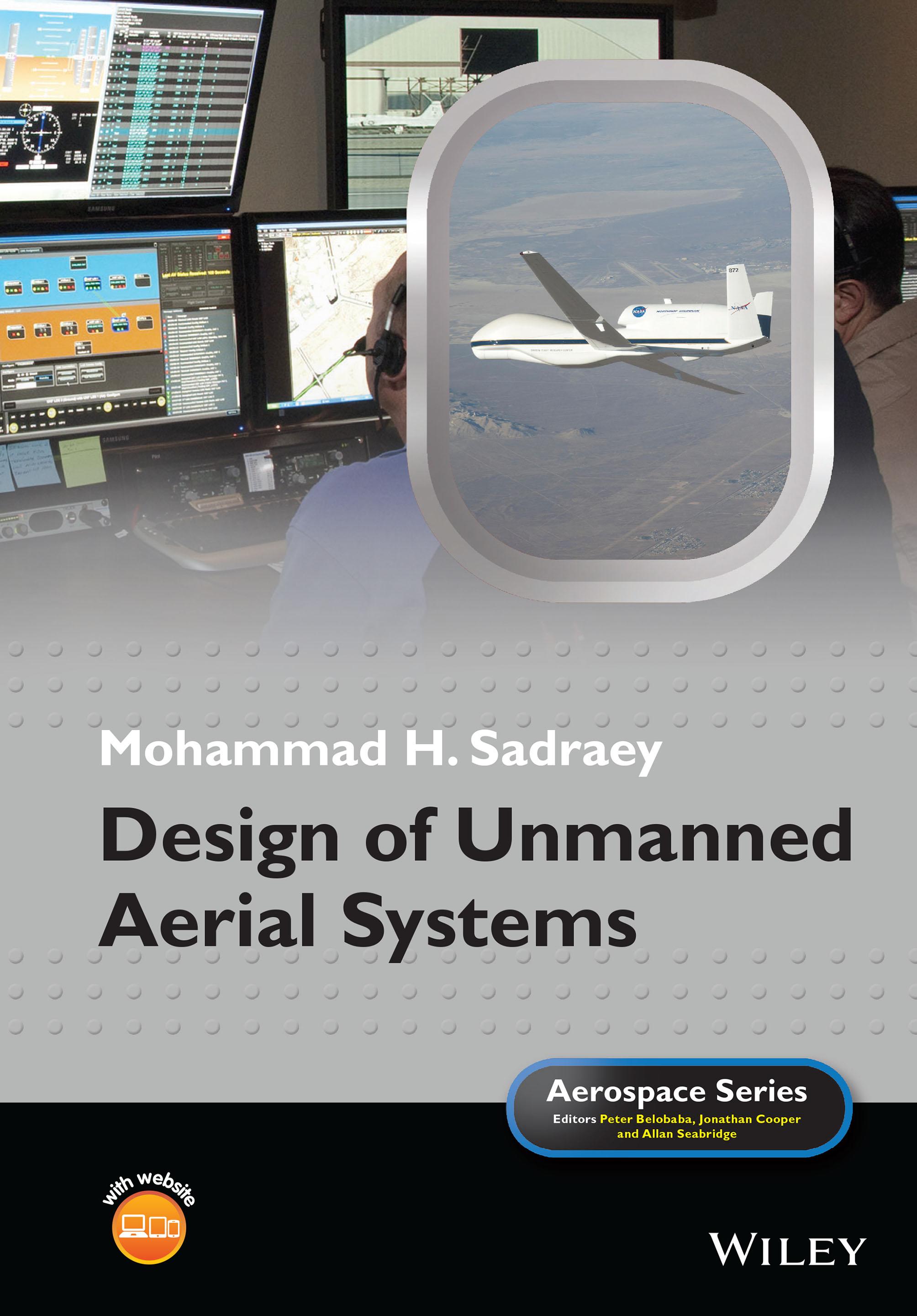Design of Unmanned Aerial Systems
Dr. Mohammad H. Sadraey
Southern New Hampshire University
Manchester, NH, USA
This edition first published 2020
© 2020 John Wiley & Sons Ltd
All rights reserved. No part of this publication may be reproduced, stored in a retrieval system, or transmitted, in any form or by any means, electronic, mechanical, photocopying, recording or otherwise, except as permitted by law. Advice on how to obtain permission to reuse material from this title is available at http://www.wiley.com/go/permissions.
The right of Mohammad H. Sadraey to be identified as the author of this work has been asserted in accordance with law.
Registered Offices
John Wiley & Sons, Inc., 111 River Street, Hoboken, NJ 07030, USA
John Wiley & Sons Ltd, The Atrium, Southern Gate, Chichester, West Sussex, PO19 8SQ, UK
Editorial Office
The Atrium, Southern Gate, Chichester, West Sussex, PO19 8SQ, UK
For details of our global editorial offices, customer services, and more information about Wiley products visit us at www.wiley.com.
Wiley also publishes its books in a variety of electronic formats and by print-on-demand. Some content that appears in standard print versions of this book may not be available in other formats.
Limit of Liability/Disclaimer of Warranty
In view of ongoing research, equipment modifications, changes in governmental regulations, and the constant flow of information relating to the use of experimental reagents, equipment, and devices, the reader is urged to review and evaluate the information provided in the package insert or instructions for each chemical, piece of equipment, reagent, or device for, among other things, any changes in the instructions or indication of usage and for added warnings and precautions. While the publisher and authors have used their best efforts in preparing this work, they make no representations or warranties with respect to the accuracy or completeness of the contents of this work and specifically disclaim all warranties, including without limitation any implied warranties of merchantability or fitness for a particular purpose. No warranty may be created or extended by sales representatives, written sales materials or promotional statements for this work. The fact that an organization, website, or product is referred to in this work as a citation and/or potential source of further information does not mean that the publisher and authors endorse the information or services the organization, website, or product may provide or recommendations it may make. This work is sold with the understanding that the publisher is not engaged in rendering professional services. The advice and strategies contained herein may not be suitable for your situation. You should consult with a specialist where appropriate. Further, readers should be aware that websites listed in this work may have changed or disappeared between when this work was written and when it is read. Neither the publisher nor authors shall be liable for any loss of profit or any other commercial damages, including but not limited to special, incidental, consequential, or other damages.
Library of Congress
Cataloging-in-Publication Data
Names: Sadraey, Mohammad H., author.
Title: Design of unmanned aerial systems / Dr. Mohammad H. Sadraey.
Description: First edition. | Hoboken, NJ: John Wiley & Sons, 2020. |
Series: Aerospace series | Includes bibliographical references and index.
Identifiers: LCCN 2019024537 (print) | LCCN 2019024538 (ebook) | ISBN 9781119508700 (hardback) | ISBN 9781119508694 (adobe pdf) | ISBN 9781119508625 (epub)
Subjects: LCSH: Drone aircraft–Design and construction.
Classification: LCC TL685.35 .S235 2019 (print) | LCC TL685.35 (ebook) | DDC 629.133/39–dc23
LC record available at https://lccn.loc.gov/2019024537
LC ebook record available at https://lccn.loc.gov/2019024538
Cover image: © NASA, © NASA/Tony Landis
Cover design by Wiley
Set in 10/12pt Warnock by SPi Global, Pondicherry, India
9 8 7 6 5 4 3 2 1
To Fatemeh Zafarani, Ahmad, and Atieh, for all their love and understanding
Contents
Preface xix
Acronyms xxv
Nomenclature xxix
About the Companion Website xxxvii
1 Design Fundamentals 1
1.1 Introduction 2
1.2 UAV Classifications 5
1.3 Review of a Few Successful UAVs 8
1.3.1 Global Hawk 8
1.3.2 RQ‐1A Predator 9
1.3.3 MQ‐9 Predator B Reaper 9
1.3.4 RQ‐5A Hunter 10
1.3.5 RQ‐7 Shadow 200 10
1.3.6 RQ‐2A Pioneer 11
1.3.7 RQ‐170 Sentinel 11
1.3.8 X‐45A UCAV 12
1.3.9 Epson Micro‐flying Robot 12
1.4 Design Project Planning 12
1.5 Decision Making 13
1.6 Design Criteria, Objectives, and Priorities 15
1.7 Feasibility Analysis 17
1.8 Design Groups 17
1.9 Design Process 18
1.10 Systems Engineering Approach 19
1.11 UAV Conceptual Design 21
1.12 UAV Preliminary Design 27
1.13 UAV Detail Design 28
1.14 Design Review, Evaluation, Feedback 30
1.15 UAV Design Steps 30
Questions 32
2 Preliminary Design 35
2.1 Introduction 35
2.2 Maximum Takeoff Weight Estimation 36
2.3 Weight Buildup 36
2.4 Payload Weight 37
2.5 Autopilot Weight 37
2.6 Fuel Weight 39
2.7 Battery Weight 43
2.8 Empty Weight 47
2.9 Wing and Engine Sizing 48
2.10 Quadcopter Configuration 52 Questions 60 Problems 61
3 Design Disciplines 65
3.1 Introduction 66
3.2 Aerodynamic Design 67
3.3 Structural Design 69
3.4 Propulsion System Design 71
3.4.1 General Design Guidelines 72
3.4.2 Electric Engines 74
3.5 Landing Gear Design 75
3.6 Mechanical and Power Transmission Systems Design 78
3.7 Electric Systems 80
3.7.1 Fundamentals 80
3.7.2 Safety Recommendations 81
3.7.3 Wiring Diagrams 82
3.7.4 Wire Insulation and Shielding 83
3.7.5 Batteries 83
3.7.6 Generator 84
3.8 Control Surfaces Design 85
3.9 Safety Analysis 90
3.9.1 Design Lessons Learned 91
3.9.2 Likely Failure Modes of Sub‐Systems/Components 93
3.10 Installation Guidelines 95
3.10.1 GPS/Compass 95
3.10.2 IMU 95
3.10.3 Electric Motor 96 Questions 96
Design Questions 97 Problems 99
4 Aerodynamic Design 101
4.1 Introduction 102
4.2 Fundamentals of Aerodynamics 103
4.3 Wing Design 104
4.3.1 Wing Design Procedure 105
4.3.2 Airfoil Selection/Design 106
4.3.3 Wing Design Technique 108
4.3.4 Wing Design Steps 113
4.4 Tail Design 113
4.4.1 Design Procedure 113
4.4.2 Tail Configuration 115
4.4.3 Horizontal Tail Design Technique 116
4.4.4 Tail Planform Area and Tail Arm 117
4.4.5 Tail Airfoil Section 118
4.4.6 Tail Incidence 119
4.4.7 Other Horizontal Tail Parameters 119
4.5 Vertical Tail Design 119
4.5.1 Parameters 119
4.5.2 Vertical Tail Location 120
4.5.3 Vertical Tail Moment Arm (lvt) 120
4.5.4 Planform Area (Sv) 120
4.5.5 Incidence (iv) 121
4.5.6 Other Vertical Tail Parameters 122
4.5.7 Vertical Tail Design Technique 122
4.6 Fuselage Design 123
4.6.1 Fuselage Design Fundamentals 123
4.6.2 Fuselage Aerodynamics 123
4.6.3 Autopilot Compartment 126
4.6.4 Optimum Length‐to‐Diameter Ratio 126
4.6.5 Fuselage Aerodynamics 127
4.6.6 Lofting 128
4.6.7 Fuselage Design Steps 129
4.7 Antenna 130
4.7.1 Fixed Antenna 130
4.7.2 Radar Dish Antenna 131
4.7.3 Satellite Communication Antenna 131
4.7.4 Antenna Design/Installation 132
4.8 Aerodynamic Design of Quadcopters 132
4.9 Aerodynamic Design Guidelines 133 Questions 134 Problems 136
5 Fundamentals of Autopilot Design 141
5.1 Introduction 142
5.1.1 Autopilot and Human Operator 143
5.1.2 Primary Subsystems of an Autopilot 144
5.1.3 Autopilot Design or Selection 145
5.2 Dynamic Modeling 146
5.2.1 Modeling Technique 146
5.2.2 Fundamental Model 148
5.2.3 Transfer Function 150
5.2.4 State‐Space Representation 152
5.3 Aerodynamic Forces and Moments 153
5.3.1 Forces and Moments Equations 153
5.3.2 Stability and Control Derivatives 154
5.3.3 Non‐dimensional Stability and Control Derivatives 154
5.3.4 Dimensional Stability and Control Derivatives 155
5.3.5 Coupling Stability Derivatives 156
5.4 Simplification Techniques of Dynamic Models 157
5.4.1 Linearization 157
5.4.1.1 Taylor Series 158
5.4.1.2 Direct Technique 159
5.4.2 Decoupling 159
5.5 Fixed‐Wing UAV Dynamic Models 161
5.5.1 Nonlinear Fully Coupled Equations of Motion 162
5.5.2 Nonlinear Semi‐Coupled Equations of Motion 162
5.5.3 Nonlinear Decoupled Equations of Motion 163
5.5.4 Linear Coupled Equations of Motion 163
5.5.5 Linear Decoupled Equations of Motion 165
5.5.6 Reformulated (Nonlinear Semi‐Coupled) Equations of Motion 167
5.5.7 Un‐powered Gliding Equations of Motion 168
5.6 Dynamic Model Approximation 169
5.6.1 Pure Pitching Motion Approximation 169
5.6.2 Pure Rolling Motion Approximation 169
5.6.3 Pure Yawing Motion Approximation 169
5.6.4 Longitudinal Oscillatory Modes Approximation 170
5.7 Quadcopter (Rotary‐Wing) Dynamic Model 170
5.7.1 Overall Thrust of Four Motors 170
5.7.2 Dynamic Model 174
5.7.3 Simplified Dynamic Model 175
5.8 Autopilot Categories 176
5.8.1 Stability Augmentation 176
5.8.2 Hold Functions 178
5.8.3 Navigation Functions 180
5.8.4 Command Augmentation Systems 180
5.9 Flight Simulation – Numerical Methods 181
5.9.1 Numerical Integration 182
5.9.2 Matlab/Simulink 182
5.9.3 Hardware‐In‐the‐Loop Simulation 184
5.10 Flying Qualities for UAVs 185
5.10.1 Fundamentals 185
5.10.2 Classes, Categories, and Acceptability Levels 186
5.10.3 Force Restrictions 186
5.11 Autopilot Design Process 187 Questions 188 Problems 190
6 Control System Design 195
6.1 Introduction 196
6.2 Fundamentals of Control Systems 197
6.2.1 Elements, Concepts and Definitions 197
6.2.2 Root Locus Design Technique 199
6.2.3 Frequency Domain Design Technique 200
6.2.4 Controller Configurations and Control Architectures 201
6.3 Servo/Actuator 203
6.3.1 Terminology 203
6.3.2 Electric Motors 204
6.3.3 Hydraulic Actuator 206
6.3.4 Delay 206
6.3.5 Saturation 207
6.4 Flight Control Requirements 207
6.4.1 Longitudinal Control Requirements 207
6.4.2 Roll Control Requirements 208
6.4.3 Directional Control Requirements 209
6.5 Control Modes 209
6.5.1 Coupled Control Modes 210
6.5.2 Cruise Control 212
6.5.3 Pitch‐Attitude Hold 213
6.5.4 Wing Leveler 214
6.5.5 Yaw Damper 215
6.5.6 Auto‐Landing 217
6.5.7 Turn Coordinator 218
6.6 Controller Design 223
6.6.1 PID Controller 223
6.6.2 Optimal Control – LQR 224
6.6.3 Gain Scheduling 229
6.6.4 Robust Control 231
6.6.5 Digital Control 233
6.7 Autonomy 234
6.7.1 Classification 234
6.7.2 Detect (i.e., Sense)‐and‐Avoid 235
6.7.3 Automated Recovery 236
6.7.4 Fault Monitoring 236
6.7.5 Intelligent Flight Planning 236
6.8 Manned–Unmanned Aircraft Teaming 237
6.8.1 Need for Teaming 237
6.8.2 Teaming Problem Formulation 237
6.8.3 Decision Making Process 239
6.8.4 Teaming Communication Process 241
6.8.5 Teaming Laws 242
6.9 Control System Design Process 243 Questions 246 Problems 249
7 Guidance System Design 255
7.1 Introduction 256
7.2 Fundamentals 257
7.2.1 Guidance Process 257
7.2.2 Elements of Guidance System 258
7.2.3 Guidance Components 259
7.2.4 Target Detection 260
7.2.5 Moving Target Tracking 262
7.3 Guidance Laws 263
7.4 Command Guidance Law 265
7.5 PN Guidance Law 269
7.6 Pursuit Guidance Law 273
7.7 Waypoint Guidance Law 274
7.7.1 Waypoints 274
7.7.2 Types of Waypoint Guidance 275
7.7.3 Segments of a Horizontal (Level) Trajectory 276
7.7.4 Waypoint Guidance Algorithm 278
7.7.4.1 Trajectory Smoother 278
7.7.4.2 Trajectory Tracking 279
7.7.5 UAV Maneuverability Evaluation 281
7.8 Sense and Avoid 282
7.8.1 Fundamentals 282
7.8.2 Sensing Techniques 283
7.8.3 Collision Avoidance 286
7.9 Formation Flight 291
7.10 Motion Planning and Trajectory Design 293
7.11 Guidance Sensor – Seeker 294
7.12 Guidance System Design 296 Questions 298 Problems 300
8 Navigation System Design 305
8.1 Introduction 306
8.2 Classifications 307
8.3 Coordinate Systems 309
8.3.1 Fixed and Moving Frames 309
8.3.2 World Geodetic System 310
8.4 Inertial Navigation System 311
8.4.1 Fundamentals 311
8.4.2 Navigation Equations 313
8.4.3 Navigation Basic Calculations 313
8.4.4 Geodetic Coordinates Calculations 314
8.5 Kalman Filtering 315
8.6 Global Positioning System 317
8.6.1 Fundamentals 317
8.6.2 Earth Longitude and Latitude 319
8.6.3 Ground Speed Versus Airspeed 322
8.7 Position Fixing Navigation 322
8.7.1 Map Reading 322
8.7.2 Celestial Navigation 322
8.8 Navigation in Reduced Visibility Conditions 323
8.9 Inertial Navigation Sensors 323
8.9.1 Primary Functions 323
8.9.2 Accelerometer 324
8.9.3 Gyroscope 326
8.9.4 Airspeed Sensor 329
8.9.5 Altitude Sensor 330
8.9.5.1 Radar Altimeter 330
8.9.5.2 Mechanical Altimeter 330
8.9.6 Pressure Sensor 332
8.9.7 Clock/Timer 332
8.9.8 Compass 332
8.9.9 Magnetometer 333
8.9.10 MEMS Inertial Module 333
8.9.11 Transponder 335
8.10 Navigation Disturbances 335
8.10.1 Wind 335
8.10.2 Gust and Disturbance 337
8.10.3 Measurement Noise 339
8.10.4 Drift 340
8.10.4.1 Drift Due to Rotation of Rotor/Propeller 340
8.10.4.2 Drift Due to Wind 342
8.10.5 Coriolis Effect 342
8.10.6 Magnetic Deviation 344
8.11 Navigation System Design 345
8.11.1 Design Requirements 345
8.11.2 Design Flowchart 346
8.11.3 Design Guidelines 347 Questions 348 Problems 351
9 Microcontroller 355
9.1 Introduction 356
9.2 Basic Fundamentals 358
9.2.1 Microcontroller Basics 358
9.2.2 Microcontroller Versus Microprocessor 361
9.2.3 Packaging Formats 361
9.2.4 Modules/Components 363
9.2.5 Atmel ATmega644P 365
9.3 Microcontroller Circuitry 367
9.3.1 Microcontroller Circuit Board 367
9.3.2 Electric Motor 367
9.3.3 Servo Motor 368
9.3.4 Sensors 368
9.3.5 Potentiometer 369
9.4 Embedded Systems 369
9.4.1 Introduction 369
9.4.2 Embedded Processors 369
9.4.3 Signal Flow 370
9.5 Microcontroller Programming 371
9.5.1 Software Development 371
9.5.2 Operating System 371
9.5.3 Management Software 371
9.5.4 Microcontroller Programing 372
9.5.5 Software Integration 372
9.5.6 High‐Level Programming Languages 373
9.5.7 Compiler 374
9.5.8 Debugging 374
9.6 Programming in C 374
9.6.1 Introduction 374
9.6.2 General Structure of a C Program 374
9.6.3 Example Code – Detecting a Dead LED 375
9.6.4 Execution of a C Program 377
9.7 Arduino 378
9.7.1 Arduino Overview 378
9.7.2 Arduino Programming 379
9.7.3 Arduino Uno Board 380
9.7.4 Open‐Loop Control of an Elevator 382
9.7.5 Arduino and Matlab 383
9.8 Open‐Source Commercial Autopilots 384
9.8.1 ArduPilot 384
9.8.2 PX4 Pixhawk Autopilot 385
9.8.3 Micropilot 386
9.8.4 DJI WooKong Autopilot 387
9.9 Design Procedure 387
9.10 Design Project 388
9.10.1 Problem Statement 389
9.10.2 Design and Implementation 389
9.10.3 Arduino Code 389
9.10.4 Procedure 391
9.10.5 MATLAB Code for Real‐Time Plotting 392
9.10.6 System Response and Results 393 Questions 393 Problems 395 Design Projects 397
10 Launch and Recovery Systems Design 399
10.1 Introduction 400
10.2 Launch Technologies and Techniques 402
10.2.1 Rocket Assisted Launch 402
10.2.2 Bungee Cord Catapult Launch 403
10.2.3 Pneumatic Launchers 406
10.2.4 Hydraulic Launchers 407
10.2.5 Air Launch 408
10.2.6 Hand Launch 409
10.3 Launcher Equipment 410
10.3.1 Elements 410
10.3.2 Ramp/Slipway 410
10.3.3 Push Mechanism 412
10.3.4 Elevation Platform 412
10.3.5 Power Supply 415
10.4 Fundamentals of Launch 415
10.4.1 Fundamental Principles 415
10.4.2 Governing Launch Equations 416
10.4.3 Wing and Horizontal Tail Contributions 419
10.4.4 UAV Longitudinal Trim 420
10.5 Elevation Mechanism Design 422
10.5.1 Elevation Mechanism Operation 422
10.5.2 Hydraulic and Pneumatic Actuators 423
10.6 VTOL 424
10.7 Recovery Technologies and Techniques 424
10.7.1 Fundamentals 424
10.7.2 Net Recovery 425
10.7.3 Arresting Line 426
10.7.4 Skyhook 427
10.7.5 Windsock 427
10.7.6 Parachute 429
10.8 Recovery Fundamentals 429
10.8.1 Parachute 429
10.8.2 Impact Recovery 431
10.9 Launch/Recovery Systems Mobility 431
10.9.1 Mobility Requirements 431
10.9.2 Conventional Wheeled Vehicle 432
10.10 Launch and Recovery Systems Design 433
10.10.1 Launch and Recovery Techniques Selection 433
10.10.2 Launch System Design 434
10.10.3 Recovery System Design 436 Questions 437 Problems 440 Design Projects 443
11 Ground Control Station 445
11.1 Introduction 446
11.2 GCS Subsystems 448
11.3 Types of Ground Stations 448
11.3.1 Handheld Radio Controller 449
11.3.1.1 General Structure 449
11.3.1.2 Stick 450
11.3.1.3 Potentiometer 452
11.3.2 Portable GCS 453
11.3.3 Mobile Truck 454
11.3.4 Central Command Station 458
11.3.5 Sea Control Station 459
11.3.6 General GCS 459
11.4 GCS of a Number of UAVs 460
11.4.1 Global Hawk 460
11.4.2 Predator 461
11.4.3 MQ‐5A Hunter 462
11.4.4 Shadow 200 462
11.4.5 DJI Phantom 463
11.4.6 Yamaha RMAX Unmanned Helicopter 464
11.5 Human‐Related Design Requirements 464
11.5.1 Number of Pilots/Operators in Ground Station 464
11.5.2 Ergonomics 464
11.5.3 Features of a Human Pilot/Operator 466
11.5.4 Console Dimensions and Limits 467
11.6 Support Equipment 469
11.6.1 Introduction 469
11.6.2 Transportation Equipment 470
11.6.3 Power Generator 471
11.6.4 HVAC System 471
11.6.5 Other Items 471
11.7 GCS Design Guidelines 472 Questions 473 Problems 475
Design Problems 476 Laboratory Experiments 477
12 Payloads Selection/Design 481
12.1 Introduction 482
12.2 Elements of Payload 483
12.2.1 Payload Definition 483
12.2.2 Payloads Classifications 484
12.3 Payloads of a Few UAVs 484
12.3.1 RQ‐4 Global Hawk 485
12.3.2 MQ‐9 Predator B Reaper 485
12.3.3 RQ‐7 Shadow 200 486
12.3.4 RQ‐5A Hunter 486
12.3.5 DJI Phantom Quadcopter 486
12.3.6 X‐45 UCAV 487
12.3.7 Yamaha RMAX 487
12.4 Cargo or Freight Payload 487
12.5 Reconnaissance/Surveillance Payload 488
12.5.1 Electro‐Optical Camera 489
12.5.2 Infra‐Red Camera 494
12.5.3 Radar 495
12.5.3.1 Fundamentals 495
12.5.3.2 Radar Governing Equations 497
12.5.3.3 An Example 498
12.5.3.4 A Few Applications 500
12.5.4 Lidar 502
12.5.5 Range Finder 502
12.5.6 Laser Designator 504
12.5.7 Radar Warning Receiver 505
12.6 Scientific Payloads 505
12.6.1 Classifications 505
12.6.2 Temperature Sensor 507
12.7 Military Payloads 508
12.8 Electronic Counter Measure Payloads 509
12.9 Payload Installation 511
12.9.1 Payload Wiring 511
12.9.2 Payload Location 512
12.9.3 Payload Aerodynamics 513
12.9.4 Payload‐Structure Integration 517
12.9.5 Payload Stabilization 519
12.10 Payload Control and Management 520
12.11 Payload Selection/Design Guidelines 520
Questions 523
Problems 525
Design Problems 527
13 Communications System Design 531
13.1 Fundamentals 532
13.2 Data Link 534
13.3 Transmitter 536
13.4 Receiver 537
13.5 Antenna 539
13.6 Radio Frequency 541
13.7 Encryption 544
13.8 Communications Systems of a Few UAVs 545
13.9 Installation 547
13.10 Communications System Design 547
13.11 Bi‐directional Communications Using Arduino Boards 548
13.11.1 Communications Modules 548
13.11.2 NRF24L01 Module 549
13.11.3 Bluetooth Module 553
13.11.4 An Application 554
Questions 558
Problems 560 Laboratory Experiments 561
Design Projects 562
14 Design Analysis and Feedbacks 565
14.1 Introduction 566
14.2 Design Feedbacks 567
14.3 Weight and Balance 569
14.3.1 UAV Center of Gravity 569
14.3.2 Weight Distribution 571
14.4 Stability Analysis 573
14.4.1 Fundamentals 573
14.4.2 Static Longitudinal Stability 574
14.4.3 Dynamic Longitudinal Stability 574
14.4.4 Static Lateral‐Directional Stability 575
14.4.5 Dynamic Lateral‐Directional Stability 576
14.4.6 Typical Values for Stability Derivatives 577
14.5 Controllability Analysis 579
14.5.1 Longitudinal Control 579
14.5.2 Lateral Control 580
14.5.3 Directional Control 581
14.5.4 Typical Values for Control Derivatives 582
14.6 Flight Performance Analysis 582
14.6.1 Maximum Speed 582
14.6.2 Maximum Range 584
14.6.3 Maximum Endurance 584
14.6.4 Climb Performance 585
14.6.4.1 Fastest Climb 585
14.6.4.2 Steepest Climb 586
14.6.5 Takeoff Performance 587
14.6.6 Turn Performance 588
14.6.7 Absolute Ceiling 590
14.6.7.1 UAV with Jet Engine(s) 591
14.6.7.2 UAV with Propeller‐driven Engine(s) 591
14.7 Cost Analysis 591
Questions 593 Problems 595
References 601 Index 609
Preface
Definitions
An Unmanned Aerial System (UAS) is a group of coordinated multidisciplinary elements for an aerial mission by employing various payloads in flying vehicle(s). In contrast, an Unmanned Aerial Vehicle (UAV) is a remotely piloted or self‐piloted aircraft that can carry payloads such as camera, radar, sensor, and communications equipment. All flight operations (including takeoff and landing) are performed without on‐board human pilot. In news and media reports, the expression “drone” – as a short term – is preferred.
A UAS basically includes five main elements: 1. Air vehicle; 2. Control station; 3. Payload; 4. Launch and recovery system, 5. Maintenance and support system. Moreover, the environment in which the UAV(s) or the systems elements operate (e.g., the airspace, the data links, relay aircraft, etc.) may be assumed as the sixth (6) inevitable element.
A UAV is much more than a reusable air vehicle. UAVs are to perform critical missions without risk to personnel and more cost effectively than comparable manned system. UAVs are air vehicles; they fly like airplanes and operate in an airplane environment. They are designed like air vehicles; they have to meet flight critical air vehicle requirements. A designer needs to know how to integrate complex, multi‐disciplinary systems, and to understand the environment, the requirements and the design challenges.
UAVs are employed in numerous flight missions; in scientific projects and research studies such as hurricane tracking, volcano monitoring, and remote sensing; and in commercial applications such as tall building and bridge observation, traffic control, tower maintenance, and fire monitoring. UAVs also present very unique opportunities for filmmakers in aerial filming/photography.
The UAVs are about to change how directors make movies in capturing the perfect aerial shot. In military arenas, UAVs may be utilized in flight missions such as surveillance, reconnaissance, intelligent routing, offensive operations, and combat. A UAV must typically be flexible, adaptable, capable of performing reconnaissance work, geo‐mapping ready, able to collect samples of various pollutants, ready to conduct “search and destroy” missions, and prepared to research in general.
There is no consensus for the definition of autonomy in UAV community. The main systems drivers for autonomy are that it should provide more flexible operation, in that the operator tells the system what is wanted from the mission (not how to do it) with the flexibility of dynamic changes to the mission goals being possible in flight with minimal operation re‐planning. Autonomy is classified in 10 levels, from remotely piloted, to fully autonomous swarm. Autonomy includes a level of artificial intelligence. An
autopilot is the main element by which the level of autonomy is determined. For instance, stabilization of an unstable UAV is a function for autopilot.
In 2018, at least 122 000 people in the U.S. are certified to fly UAVs professionally, according to the Federal Aviation Administration (FAA), which sparked the UAVs explosion in 2016 when it simplified its process for allowing their commercial use. FAA has ruled that commercial UAV flight outside a pilot’s line of sight is not allowed. About three million UAVs were sold [1] worldwide in 2017, according to Time Magazine, and more than one million UAVs are registered for US use with the FAA.
By January 2019, at least 62 countries are developing or using over 1300 various UAVs. The contributions of unmanned UAV in sorties, hours, and expanded roles continue to increase. These diverse systems range in cost from a few hundred dollars (Amazon sells varieties) to tens of millions of dollars. Range in capability from Micro Air Vehicles (MAV) weighing less than 1 lb to aircraft weighing over 40 000 lbs. UAVs will have to fit into a pilot based airspace system. Airspace rules are based on manned aircraft experience.
Objectives
The objective of this book is to provide a basic text for courses in the design of UASs and UAVs at both the upper division undergraduate and beginning graduate levels. Special effort has been made to provide knowledge, lessons, and insights into UAS technologies and associated design techniques across various engineering disciplines. The author has attempted to comprehensively cover all the main design disciplines that are needed for a successful UAS design project. To cover such a broad scope in a single book, depths in many areas have to be sacrificed.
UAVs share much in common with manned aircraft. The design of manned aircraft and the design of UAVs have many similarities; and some differences. The similarities include: 1. Design process; 2. Constraints (e.g., g‐load, pressurization); and 3. UAV main components (e.g., wing, tail, fuselage, propulsion system, structure, control surfaces, and landing gear). The differences include: 1. Autopilot, 2. Communication system, 3. Sensors, 4. Payload, 5. Launch and recovery system, and 6. Ground control station.
The book is primarily written with the objective to be a main source for a UAS chief designer. The techniques presented in this book are suitable for academic study, and teaching students. The book can be adopted as the main text for a single elective course in UAS and UAV design for engineering programs. This text is also suitable for professional continuing education for individuals who are interested in UASs. Industries engineers with various backgrounds can learn about UAS and prepare themselves for new roles in UAS design project.
Approach
The process of UAS design is a complex combination of numerous disciplines which have to be blended together to yield the optimum design to meet a given set of requirements. This is a true statement “the design techniques are not understood unless practiced.” Therefore, the reader is highly encouraged to experience the design techniques and concepts through application projects. The instructors are also encouraged to
define an open‐ended semester−/year‐long UAS design project to help the students to practice and learn through the application and experiencing the iterative nature of the design technique. It is my sincere wish that this book will help aspiring students and design engineers to learn and create more efficient and safer UASs, and UAVs.
In this text, the coverage of the topics which are similar to that of a manned aircraft is reviewed. However, the topics which are not covered in a typical manned aircraft design book, are presented in detail. The author has written a book on manned aircraft design – Aircraft Design, a Systems Engineering Approach – published by Wiley. In several topics, the reader recommends the reader to study that text for the complete details. Some techniques (e.g., matching plot) deviate from traditional aircraft design. Throughout the text, the systems engineering approach is examined and implemented.
A UAV designer must: (a) be knowledgeable on the various related engineering topics; (b) be aware of the latest UAV developments; (c) be informed of the current technologies; (d) employ lessons learned from past failures; and (e) appreciate breadth of UAV design options.
A design process requires both integration and iteration. A design process includes: 1. Synthesis: the creative process of putting known things together into new and more useful combinations. 2. Analysis: the process of predicting the performance or behavior of a design candidate. 3. Evaluation: the process of performance calculation and comparing the predicted performance of each feasible design candidate to determine the deficiencies.
UAVs are typically smaller than manned aircraft, have a reduced radar signature, and an increased range and endurance. A UAV designer is also involved in mission planning. Payload type has a direct effect of mission planning. For any mission, the commander seeks to establish criteria that maximize his probability of success. Planning considerations are cost dependent. A UAV can be designed for both scientific purposes and for the military. Their once reconnaissance only role is now shared with strike, force protection, and signals collection.
Beyond traditional aircraft design topics, this text presents detail design of launchers, recovery systems, communication systems, electro‐optic/infrared cameras, ground control station, autopilot, radars, scientific sensors, flight control system, navigation system, guidance system, and microcontrollers.
Outline
The objective of the book is to review the design fundamentals of UAVs, as well as the coverage of the design techniques of the UASs. The book is organized into 14 Chapters. Chapter 1 is devoted to design fundamentals including design process, and three design phases (i.e., conceptual, preliminary, and detail). The preliminary design phase is presented in Chapter 2 to determine maximum takeoff weight, wing reference planform area, and engine thrust/power. Various design disciplines including propulsion system, electric system, landing gear, and safety analysis are covered in Chapter 3. The aerodynamic design of wing, horizontal tail, vertical tail, and fuselage is provided in Chapter 4.
Fundamentals of autopilot design including UAV dynamic modeling, autopilot categories, flight simulation, flying qualities for UAVs, and autopilot design process is discussed in Chapter 5. The detail design of control system, guidance system, and
navigation system are covered in Chapters 6, 7, and 8 respectively. As the heart of autopilot, the design and application of microcontrollers are explained in Chapter 9. In this Chapter, topics such as microcontroller circuitry, microcontroller elements, embedded systems, and programming are described. Moreover, features of a number of open‐source commercial microcontrollers and autopilots (e.g., Arduino and Ardupilot) are introduced. Chapters 10 and 11 are dedicated to two subsystems of a UAS; namely launch and recovery systems, and ground control station. In both chapters, fundamentals, equipment, types, governing equations, ergonomics, technologies, and design techniques are presented.
The payload selection and design is provided in Chapter 12. Various types of payloads including cargo, electro‐optic cameras, infrared sensors, range finders, radars, lidars, scientific payloads, military payloads, and electronic counter measure equipment are considered in this chapter. The communications system (including transmitter, receiver, antenna, datalink, frequencies, and encryption) design is discussed in Chapter 13. Finally, in Chapter 14, various design analysis and evaluation techniques; mainly weight and balance, stability analysis, control analysis, performance analysis, and cost analysis techniques are discussed.
Special effort has been made to provide example problems so that the reader will have a clear understanding of the topic discussed. The book contains many fully solved examples in various chapters to exhibit the applications of the design techniques presented. Each chapter concludes with questions and problems; and some chapters with design problems and lab experiments. A solutions manual and figures library are available for instructors who adopt this book.
Quadcopters
Due to the popularity and uniqueness of quadcopters in aeronautics/aviation and commercial applications, this type of UAV is specially treated in this book. A number of sections in various chapters are dedicated to the configuration design, aerodynamic design, and control of quadcopters as follows: Section 2.10. Quadcopter configuration, Section 4.8. Aerodynamic design of quadcopters, and Section 5.7. Quadcopter dynamic model.
Unit System
In this text, the emphasize is on the SI units or metric system; which employs the meter (m) as the unit of length, the kilogram (kg) as the unit of mass, and the second (s) as the unit of time. The metric unit system is taken as fundamental, this being the educational basis in the most parts of the world. It is true that metric units are more universal and technically consistent than British units. However, currently, many Federal Aviation Regulations (FARs) are published in British Units; where the foot (ft) is the unit of length/altitude, the slug is the unit of mass, pound (lb) is the unit of force (weight), and the second (s) as the unit of time. British/imperial units are still used extensively, particularly in the USA, and by industries and other federal agencies and organizations in aviation, such as FAA and NASA.
In FARs, the unit of pound (lb) is used as the unit for force and weight, knot for airspeed, and foot for altitude. Thus, in various locations, the knot is mainly used as the unit of airspeed, lb for weight and force and, ft as the unit of altitude. Therefore, in this text, a combination of SI unit and British unit systems is utilized. For dimensional examples in the text and diagrams, both units are used which it is felt have stood the test of time and may well continue to do so.
In many cases, units in both systems are used, in other cases reference may need to be made to the conversion tables. In either system, units other than the basic one are sometimes used, depending on the context; this is particularly so for weight/mass and airspeed. For instance, the UAV airspeed is more conveniently expressed in kilometers/ hour or in knots than in meters/second or in feet/second. For the case of weight/mass, the unit of kg is employed for maximum takeoff mass, while the unit of pound (lb) is utilized for the maximum takeoff weight.
Acknowledgment
Putting a book together requires the talents of many people, and talented individuals abound at Wiley Publishers. My sincere gratitude goes to Eric Willner and Steven Fassioms, executive editors of engineering, Thilagavathy Mounisamy, production editor, and Sashi Samuthiram for composition. My special thanks go to Mary Malin, as outstanding copy editor and proof‐reader that are essential in creating an error‐free text. I especially owe a large debt of gratitude to my students and the reviewers of this text. Their questions, suggestions, and criticisms have helped me to write more clearly and accurately and have influenced markedly the evolution of this book.
January 2019 Mohammad H. Sadraey
Acronyms
2d Two dimensional
3d Three dimensional
AC Alternating Current, aerodynamic center
ADF Automatic direction finder
AI Artificial intelligence
AIA Aerospace Industries Association
AFCS Automatic flight control systems
APU Auxiliary power unit
ATC Air Traffic Control
C2 Command and Control
C3 Command, Control, and Communications
C4ISR Command, Control, Communications, Computer, Intelligence, Surveillance, and Reconnaissance
CFD Computational Fluid Dynamics
cg Center of gravity
CMOS Complementary metal oxide semiconductor; sensors
COTS Commercial off‐the‐shelf
DARPA Defense Advanced Research Projects Agency
DC Direct Current
DOD Department of Defense
DOF Degree of freedom
DoS Denial of Service
EO/IR Electro‐Optic/Infra‐Red
ECM Electronic Counter Measures
EM Electro Magnetic
FAA Federal Aviation Administration
FAR Federal Aviation Regulations
FBW Fly‐by‐wire
FLIR Forward looking infrared
FOV Field of view
fps ft/sec, frame/sec
GA General aviation
GCS Ground control station
GIS Geographic Information System
GNC Guidance‐Navigation‐Control
Acronyms
GPS Global Positioning System
GUI Graphical user interface
HALE High altitude long endurance
HLD High Lift Device
HTOL Horizontal takeoff and landing
HVAC Heating, Ventilation, and Air Conditioning
IC Integrated Circuit
I2C Inter‐Integrated Circuit
ILS Instrument landing system
IMU Inertial measurement unit
INS Inertial navigation system
IR Infra‐Red
ISA International Standard Atmosphere
JATO Jet assisted takeoff
KEAS Knot Equivalent Air Speed
KTAS Knot True Air Speed
LED Light emitting diode
LIDAR Light detection and ranging
LOS Line‐of‐sight
LQR Linear Quadratic Regulator
MAC Mean Aerodynamic Chord
mAh mili Ampere hour
MAV Micro Air Vehicle
MCE Mission control element
MDO Multidisciplinary design optimization
MEMS Microelectromechanical system
MIL‐STD Military Standards
MIMO Multiple‐input multiple‐output
MTBF Mean time between failures
MTI Moving Target Indicator
MTOW Maximum takeoff weight
NACA National Advisory Committee for Aeronautics
NASA National Administration for Aeronautics and Astronautics
NTSB National Transportation Safety Board
OS Operating System
PIC Pilot‐in‐Command
Pot Potentiometer
PRF Pulse‐repetition frequency
PWM Pulse Width Modulation
rad Radian
RC Remote control, Radio control
RCS Radar Cross Section
rpm Revolution per minute
RPV Remotely piloted vehicle
SAR Synthetic aperture radar
SAS Stability augmentation system
Satcom
Satellite Communication
SDRAM Synchronous dynamic random access memory
SFC Specific fuel consumption
SIGINT Signals Intelligence
SISO Single‐Input Single‐Output
sUAS small unmanned aircraft system
sUAV small unmanned aerial vehicle
TCA Traffic collision avoidance
TCAS Traffic Alert and Collision Avoidance System
TE Trailing Edge
UAS Unmanned aerial system
UAV Unmanned Aerial Vehicle
UCAV Unmanned combat air vehicle
USB Universal Serial Bus
VHF Very High Frequency
UHF Ultra High frequency
VOR Very High Frequency Omni‐Directional Range
VTOL Vertical takeoff and landing
WGS World Geodetic System
